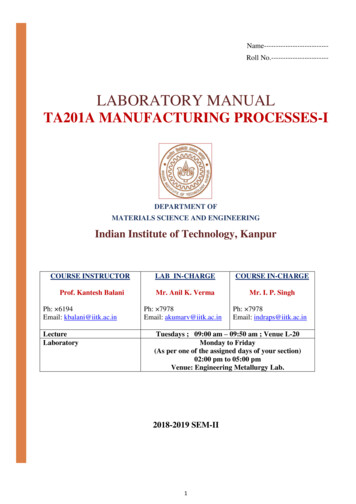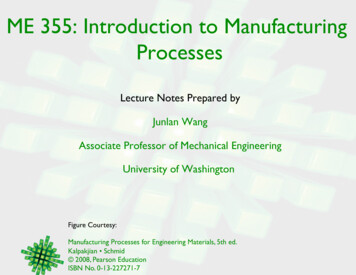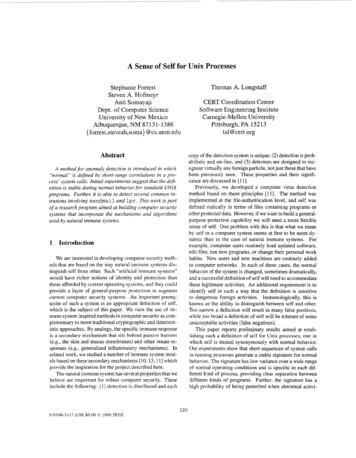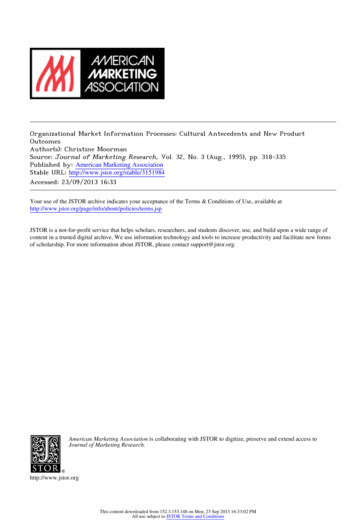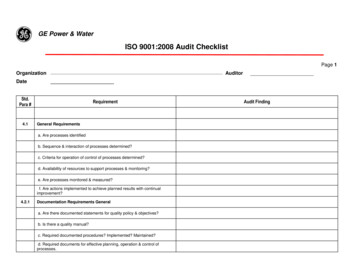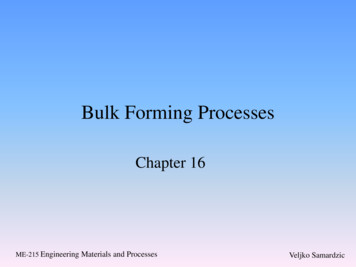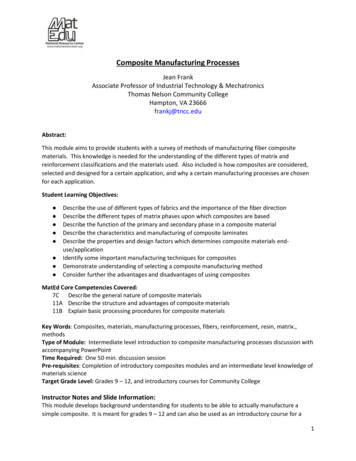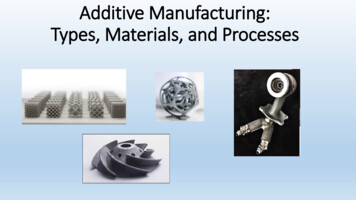
Transcription
Continue
Degarmo's materials and processes in manufacturing 12th edition solutionsInformación sobre Degarmos Materials And Processes In Manufacturing 12th Edition Pdf Download. Pdf Test Bank And Solution Manual List 2 2019 2020 Fuente : academia.edu Mechanical Engineering Aerodynamics Fuente : wiley.com Process Design Springerlink Fuente : link.springer.com Degarmos Materials AndProcesses In Manufacturing Si Version 12th Edition Global Edition Fuente : wiley.com Materials And Processes In Manufacturing By Degarmo And Fuente : faadooengineers.com Pdf Download Introduction To Solid Modeling Using Fuente : sites.google.com Información detallada sobre degarmos materials andprocesses in manufacturing 12th edition pdf download podemos compartir. Administrador blog Acerca de Materiales 2019 también recopila imágenes relacionadas con degarmos materials and processes in manufacturing 12th edition pdf download se detalla a continuación. Visite la fuente del sitio web para obtener másdetalles. Pdf C How To Program 10th Edition Free Books Fuente : sites.google.com Pdf Domain Specific Modelling Of Micro Manufacturing Fuente : researchgate.net Pdf Download Degarmos Materials And Processes In Fuente : slideshare.net Materials Processes Manufact 11e John Wiley Sons Fuente : amazon.comIntroduction To Manufacturing Processes Schey Pdf Free Fuente : michaeldigital790.weebly.com Wiley Australia Proquest Australia Proquest Titles Cron Fuente : vdocuments.site Solution Manual For Mis 8th Edition By Hossein Bidgoli Fuente : pinterest.co.uk Pdf Book Metal Cutting Theory And Practice By Fuente :academia.edu Pdf E Commerce 2016 Business Technology Society 12th Fuente : sites.google.com Solution Manual Of Introduction To Pdf Free Download Fuente : pingpdf.com Pdf A Framework For The Quality Oriented Design Of Micro Fuente : researchgate.net 100 Best Engineering Books Of All Time BookauthorityFuente : bookauthority.org Accounting Information Systems 9th Edition Gelinas Solution Fuente : issuu.com Process Design Springerlink Fuente : link.springer.com 100 Free Ebook Degarmos Materials And Processes In Fuente : medium.com Del mismo modo la información completa sobre degarmos materials andprocesses in manufacturing 12th edition pdf download. Gracias por visitar el blog Acerca de Materiales 2019. Page 2 Entradas más recientes Información sobre Journal Of Materials Chemistry B Impact Factor. Progress In Materials Scienc El administrador recopila al compartir fuentes relacionadas Como Hacer UnYoyo Con Material Reciclable. Frequently asked questionsWhat are Chegg Study step-by-step Degarmo's Materials and Processes in Manufacturing 12th Edition Solutions Manuals?Chegg Solution Manuals are written by vetted Chegg Machine Design experts, and rated by students - so you know you're getting highquality answers. Solutions Manuals are available for thousands of the most popular college and high school textbooks in subjects such as Math, Science (Physics, Chemistry, Biology), Engineering (Mechanical, Electrical, Civil), Business and more. Understanding Degarmo's Materials and Processes in Manufacturing12th Edition homework has never been easier than with Chegg Study.Why is Chegg Study better than downloaded Degarmo's Materials and Processes in Manufacturing 12th Edition PDF solution manuals?It's easier to figure out tough problems faster using Chegg Study. Unlike static PDF Degarmo's Materials andProcesses in Manufacturing 12th Edition solution manuals or printed answer keys, our experts show you how to solve each problem step-by-step. No need to wait for office hours or assignments to be graded to find out where you took a wrong turn. You can check your reasoning as you tackle a problem using ourinteractive solutions viewer.Plus, we regularly update and improve textbook solutions based on student ratings and feedback, so you can be sure you're getting the latest information available.How is Chegg Study better than a printed Degarmo's Materials and Processes in Manufacturing 12th Edition student solutionmanual from the bookstore?Our interactive player makes it easy to find solutions to Degarmo's Materials and Processes in Manufacturing 12th Edition problems you're working on - just go to the chapter for your book. Hit a particularly tricky question? Bookmark it to easily review again before an exam.The best part? As aChegg Study subscriber, you can view available interactive solutions manuals for each of your classes for one low monthly price. Why buy extra books when you can get all the homework help you need in one place?Can I get help with questions outside of textbook solution manuals?You bet! Chegg Study Expert Q&A isa great place to find help on problem sets and Machine Design study guides. Just post a question you need help with, and one of our experts will provide a custom solution. You can also find solutions immediately by searching the millions of fully answered study questions in our archive.How do I view solution manualson my smartphone?You can download our homework help app on iOS or Android to access solutions manuals on your mobile device. Asking a study question in a snap - just take a pic. DeGarmo’s Materials and Processes in Manufacturing 13th Edition J T. BLACK Auburn University-Emeritus RONALD A. KOHSERMissouri University of Science & Technology-Emeritus VP AND EDITORIAL DIRECTOR SENIOR DIRECTOR ACQUISITIONS EDITOR EDITORIAL MANAGER DEVELOPMENT EDITOR CONTENT MANAGEMENT DIRECTOR CONTENT MANAGER SENIOR CONTENT SPECIALIST PRODUCTION EDITOR PHOTORESEARCHER COVER PHOTO CREDIT Laurie Rosatone Don Fowley Jennifer Brady Judy Howarth Chris Nelson Lisa Wojcik Nichole Urban Nicole Repasky Padmapriya Soundararajan Iwan Phanbuh Tomasz Zajda / EyeEm / Getty Images; Steve Sparrow / Getty Images; Marin Tomas / Getty Images; NAN728 / Shutterstock This book was set in Source Sans Pro 9.5/12.5 by SPi Global and printed and bound by Quad Graphics. Founded in 1807, John Wiley & Sons, Inc. has been a valued source of knowledge and understanding for more than 200 years, helping people around the world meet their needs and fulfill theiraspirations. Our company is built on a foundation of principles that include responsibility to the communities we serve and where we live and work. In 2008, we launched a Corporate Citizenship Initiative, a global effort to address the environmental, social, economic, and ethical challenges we face in our business. Amongthe issues we are addressing are carbon impact, paper specifications and procurement, ethical conduct within our business and among our vendors, and community and charitable support. For more information, please visit our website: www.wiley.com/go/citizenship. Copyright 2019, 2017, 2012, 2008, 2004, 1997John Wiley & Sons, Inc. All rights reserved. No part of this publication may be reproduced, stored in a retrieval system, or transmitted in any form or by any means, electronic, mechanical, photocopying, recording, scanning or otherwise, except as permitted under Sections 107 or 108 of the 1976 United States CopyrightAct, without either the prior written permission of the Publisher, or authorization through payment of the appropriate per-copy fee to the Copyright Clearance Center, Inc., 222 Rosewood Drive, Danvers, MA 01923 (Web site: www.copyright.com). Requests to the Publisher for permission should be addressed to thePermissions Department, John Wiley & Sons, Inc., 111 River Street, Hoboken, NJ 07030-5774, (201) 748-6011, fax (201) 748-6008, or online at: www.wiley.com/go/permissions. Evaluation copies are provided to qualified academics and professionals for review purposes only, for use in their courses during the nextacademic year. These copies are licensed and may not be sold or transferred to a third party. Upon completion of the review period, please return the evaluation copy to Wiley. Return instructions and a free of charge return shipping label are available at: www.wiley.com/go/returnlabel. If you have chosen to adopt thistextbook for use in your course, please accept this book as your complimentary desk copy. Outside of the United States, please contact your local sales representative. ISBN: 978-1-119-49296-2 (PBK) ISBN: 978-1-119-49295-5 (EVAL) Library of Congress Cataloging in Publication Data: Names: Black, J. Temple, author. Kohser, Ronald A., author. Title: DeGarmo’s materials and processes in manufacturing / J.T. Black, Auburn University-Emeritus, Ronald A. Kohser, Missouri University of Science & Technology-Emeritus. Description: Thirteenth edition. Hoboken : Wiley, 2019. Includes bibliographical references and index. Identifiers:LCCN 2019001151 (print) LCCN 2019001370 (ebook) ISBN 9781119492931 (Adobe PDF) ISBN 9781119492825 (ePub) ISBN 9781119492962 (pbk.) Subjects: LCSH: Manufacturing processes. Materials. Classification: LCC TS183 (ebook) LCC TS183 .D4 2019 (print) DDC 670—dc23 LC record available atThe inside back cover will contain printing identification and country of origin if omitted from this page. In addition, if the ISBN on the back cover differs from the ISBN on this page, the one on the back cover is correct. Preface It’s a world of manufactured goods. Whether we like it or not, we all live in a technologicalsociety. Every day we come in contact with hundreds of manufactured items, made from every possible material. From the bedroom to the kitchen to the workplace, we use appliances, phones, cars, trains, and planes, TVs, cell phones, VCRs, DVDs, furniture, clothing, sports equipment, books and more. These goodsare manufactured in factories all over the world using manufacturing processes. Basically, manufacturing is a value-adding activity, where the conversion of materials into products adds value to the original material. Thus, the objective of a company engaged in manufacturing is to add value and to do so in the mostefficient manner, with the least amount of waste in terms of time, material, money, space, and labor. To minimize waste and increase productivity, the processes and operations need to be properly selected and arranged to permit smooth and controlled flow of material through the factory and provide for product variety.Meeting these goals requires an engineer who can design and operate an efficient manufacturing system. Here are some trends that are having impacts on the manufacturing world. Manufacturing is a global activity Manufacturing is a global activity with work often being performed at locations based on proximity tomaterials, labor, or marketplace. US firms often have plants in other countries, and foreign companies operate plants in the United States. Final product assembly often involves components made at a variety of locations. It’s a digital world Information technology and computers are growing exponentially, with usagein virtually every aspect of manufacturing. Design and material selection are performed on computers, and this information is then transmitted to manufacture, where machines are often operated and controlled by computers. Computerized inspection processes ensure product quality. Lean manufacturing is widelypracticed Most manufacturing companies have restructured their factories (their manufacturing systems) to become lean producers—making goods of superior quality, cheaper and faster, in a flexible way (i.e., they are more responsive to the customers). Almost every plant is doing something to become leaner. Manyhave adopted some version of the Toyota Production System. More importantly, these manufacturing factories are also designed with the internal customer (the workforce) in mind, so things such as ergonomics and safety are key design requirements. While this book is all about materials and processes for makingproducts, the design of the factory cannot be ignored when it comes to making the external customer happy with the product and the internal customer satisfied with the employer. New products and materials need new processes The number and variety of products and the materials from which they are madecontinues to proliferate, while production quantities (lot sizes) have become smaller. Existing processes must be modified to be more flexible, and new processes must be developed. Customers expect great quality Consumers want better quality and reliability, so the methods, processes, and people responsible forthat quality must improve continually. Reducing the number and magnitude of flaws and defects often requires continual changes to the manufacturing system. Rapid product development is required Being competitive often requires reducing the time to market for new products. Many companies are taking holistic orsystemwide perspectives, including concurrent engineering efforts to bring product design and manufacturing closer to the customer. Products are being designed to be easier to manufacture and assemble (design for manufacture/ assembly). Manufacturing systems are becoming more flexible (able to rapidly adapt toand assimilate new products). 3-D printing and additive manufacturing is exploding New and improved processes, new materials, and expanded capability machines and equipment are entering the market on an almost weekly basis. Technology that once produced lookalike prototype parts is now producing fullyfunctional products from the full range of materials, including metals, ceramics, polymers, and biomaterials. History of the Text E. Paul DeGarmo was a mechanical engineering professor at the University of California, Berkley, when he wrote the first edition of Materials and Processes in Manufacturing, published byMacmillan in 1957. The book quickly became the emulated standard for introductory texts in manufacturing. Second, third, and fourth editions followed in 1962, 1969, and 1974. DeGarmo began teaching at Berkeley in 1937, after earning his master’s of science degree in mechanical engineering from California Institute ofTechnology. He was a founder of the Department of Industrial Engineering (now Industrial Engineering and Operations Research) and served as its chairman from 1956–1960. He was also assistant dean of the College of Engineering for three years while continuing his teaching responsibilities. Paul DeGarmo observedthat engineering education had begun to place more emphasis on the underlying sciences at iii iv Preface the expense of hands-on experience. Most of his students were coming to college with little familiarity with materials, machine tools, and manufacturing methods that their predecessors had acquired through theirformer “shop” classes. If these engineers and technicians were to successfully convert their ideas into reality, they needed a foundation in materials and processes, with emphasis on capabilities and limitations. Paul sought to provide a text that could be used in either a one- or two-semester course designed to meetthese objectives. The materials sections were written with an emphasis on use and application. Processes and machine tools were described in terms of how they worked, what they could do, and their relative advantages and limitations, including economic considerations. The text was written for students who would beencountering the material for the first time, providing clear descriptions and numerous visual illustrations. Paul’s efforts were well-received, and the book quickly became the standard text in many schools and curricula. As materials and processes evolved, the advances were incorporated into subsequent editions.Computer usage, quality control, and automation were added to the text, along with other topics, so that it continued to provide state-of-the-art instruction in both materials and processes. As competing books entered the market, their subject material and organization tended to mimic the DeGarmo text. Paul DeGarmoretired from active teaching in 1971, but he continued his research, writing, and consulting for many years. In 1977, after the publication of the fourth edition of Materials and Processes in Manufacturing, he received a letter from Ron Kohser, then an assistant professor at the University of Missouri-Rolla, containingnumerous suggestions regarding the materials chapters. Paul DeGarmo asked Dr. Kohser to rewrite those chapters for the upcoming fifth edition. After that edition, Paul decided he was really going to retire and, after a national search, recruited J T. Black, then a professor at Ohio State, to co-author the book with Dr.Kohser. For the sixth through 12th editions (published in 1984 and 1988 by Macmillan, 1997 by Prentice Hall, and 2003, 2008 and 2012 by John Wiley & Sons), Dr. Kohser and Dr. Black have shared the responsibility for the text. The chapters about engineering materials, casting, forming, powder metallurgy, additivemanufacturing, joining and nondestructive testing have been written or revised by Dr. Kohser. Dr. Black has responsibility for the introduction and chapters about material removal, metrology, surface finishing, quality control, manufacturing systems design, and lean engineering. Paul DeGarmo died in 2000, three weeksshort of his 93rd birthday. For the 10th edition, which coincided with the 50th anniversary of the text, Dr. Black and Dr. Kohser honored their mentor with a change in the title to include his name— DeGarmo’s Materials and Processes in Manufacturing. We recognize Paul DeGarmo for his insight and leadership and areforever indebted to him for selecting us to carry on the tradition of his book for this, the 13th edition. Purpose of the Book The purpose of this book is to provide basic information on materials, manufacturing processes and systems to students of engineering and technology. The materials section focuses on propertiesand behavior. Aspects of smelting, refining, or other material production processes are presented only as they affect subsequent use and application. In terms of the processes used to manufacture items (converting materials into useful shapes with desired properties), this text seeks to provide a descriptive introductionto a wide variety of options, emphasizing how each process works and its relative advantages and limitations. The goal is to present this material in a way that can be understood by individuals seeing it for the very first time. This is not a graduate text where the objective is to thoroughly understand and optimizemanufacturing processes. Mathematical models and analytical equations are used only when they enhance the basic understanding of the material. Although the text is introductory in nature, new and emerging technologies, such as direct-digital and micro- and nano-manufacturing processes, are included as theytransition into manufacturing usage. Organization of the Book E. Paul DeGarmo wanted a book that explained to engineers how the things they designed could be made. DeGarmo’s Materials and Processes in Manufacturing is still being written to provide a broad, basic introduction to the fundamentals of manufacturing.The text begins with a survey of engineering materials, the “stuff” that manufacturing begins with, and seeks to provide the basic information that could be used to match the properties of a material to the service requirements of a component. A variety of engineering materials are presented, along with their propertiesand means of modifying them. The materials section can be used in curricula that lack preparatory courses in metallurgy, materials science, or strength of materials, or where the student has not yet been exposed to those topics. In addition, various chapters in this section can be used as supplements to a basic materialscourse, providing additional information about topics such as heat treatment, plastics, composites, and material selection. Following the materials chapters are sections about casting, powder metallurgy, forming, material removal, and joining. Each section begins with a presentation of the fundamentals on which thoseprocesses are based. These introductions are followed by a discussion about the various process alternatives, which can be selected to operate individually or be combined into an integrated system. Reflecting the many recent developments and extreme interest in additive manufacturing (often called 3-D printing), thechapter about this technology has been significantly updated to present the various technologies in place at the time of textbook printing. Uses and applications are summarized, including prototype manufacture, rapid tooling, and directdigital manufacture. The advantages and limitations of additive manufacturing aresummarized, along with a description of current and future trends. Manufacturing processes are often designed to accommodate specific materials. A separate chapter presents those processes that are somewhat unique to plastics, ceramics, and composites. Preface Chapters have been included to provideinformation about surface engineering, measurements, nondestructive testing, and quality control. Engineers need to know how to determine process capability and, if they get involved in Six Sigma projects, to know what sigma really measures. There is also introductory material about surface integrity, since so manyprocesses produce the finished surface and impart residual stresses to the components. Many of the advances in manufacturing relate to the way the various processes are implemented and integrated in a production plant or on the shop floor—the design of manufacturing systems. Aspects of automation, numericalcontrol, and robotics are presented in a separate chapter. In addition, there is expanded coverage of lean engineering, in which the mass production system is converted into a lean production system, capable of rapidly manufacturing variations of a product, small quantities of a product, or even one-of-a-kind items on avery flexible and continual basis. With each new edition, new and emerging technology is incorporated, and existing technologies are updated to accurately reflect current capabilities. Through its 60-year history and 12 previous editions, the DeGarmo text was often the first introductory book to incorporate processes suchas frictionstir welding, microwave heating and sintering, and machining dynamics. This 13th edition is published as an enhanced eText. Each chapter includes review questions that allow the student to check their understanding. A number of these questions include answers the student can access with a click or tap. TheProblems section further applies this understanding, with a bit of focus on application, including a selection of new problems added for this edition. An increased number of somewhat open-ended case studies also are provided in the eText. These have been designed to make students aware of the great importance ofproperly integrating design, material selection, and manufacturing to produce cost-competitive, reliable products. The DeGarmo text is intended for use by engineering (mechanical, lean, manufacturing, industrial, and materials) and engineering technology students, in both two- and fouryear undergraduate degreeprograms. In addition, the book is also used by engineers and technologists in other disciplines concerned with design and manufacturing (such as aerospace and electronics). Factory personnel find this book to be a valuable reference that concisely presents the various production alternatives and the advantages andlimitations of each. Additional or more in-depth information about specific materials or processes can be found in an expanded list of supplemental references that is organized by topic. Supplements An instructor solutions manual for instructors adopting the text for use in their courses is available on a companionwebsite: www.wiley.com/go/black/degarmomaterials13E. Additional student practice questions also are available from the companion site. v Acknowledgments The authors wish to acknowledge the multitude of assistance, information, and illustrations that have been provided by a variety of industries, professionalorganizations, and trade associations. The text has become known for the large number of clear and helpful photos and illustrations that have been provided graciously by a variety of sources. In some cases, equipment is photographed or depicted without safety guards, so as to show important details, and personnel arenot wearing certain items of safety apparel that would be worn during normal operation. Over the many editions, hundreds of reviewers, user faculty, and students have submitted suggestions and corrections to the text. We continue to be grateful for their input. The authors also would like to acknowledge the contributionsof Dr. Elliot Stern for the dynamics of machining section in Chapter 21, Dr. Brian Paul for writing the micro-manufacturing chapter, Dr. Kavit Antani for his contributions in lean engineering and system design, Dr. Andres Carrano for his work in measurements/metrology, Prof. Julia Morse for her contributions to NC andCNC, and Mr. Kevin Slattery of the Boeing Company for his review of the chapter on additive manufacturing. The authors want to thank Prof. Salah U. Ahmad and Prof. Farouk G. Attia, PhD, for contributing student practice questions for this edition, and Prof. Paul Liu, PhD, for helping review the questions. The authorsalso thank the John Wiley & Sons team that worked on the book, including Padmapriya Soundararajan, Judy Howarth and Chris Nelson. About the Authors J T. Black received his PhD from Mechanical and Industrial Engineering, University of Illinois, Urbana, in 1969, a master’s of science degree in industrial engineeringfrom West Virginia University in 1963, and his bachelor of science degree in industrial engineering, Lehigh University, in 1960. J T. is professor emeritus from Industrial and Systems Engineering at Auburn University. He was the chairman and a professor of Industrial and Systems Engineering at University of AlabamaHuntsville. He also taught at Ohio State University, University of Rhode Island, University of Vermont, and University of Illinois. He taught his first processes class in 1960 at West Virginia University. J T. is a Fellow in the American Society of Mechanical Engineers, the Institute of Industrial Engineering and the Society ofManufacturing Engineers. J loves to write music (mostly down-home country) and poetry, play tennis in the backyard, and show his champion pug dogs. Ron Kohser received his PhD from Lehigh University Institute for Metal Forming in 1975. He then joined the faculty of the University of Missouri-Rolla, now the MissouriUniversity of Science & Technology, where he held positions of professor of metallurgical engineering, dean’s teaching scholar, department chairman and associate dean for undergraduate instruction. Ron consistently carried a full teaching load, including metallurgy for engineers; introduction to manufacturing processes;material selection, fabrication, and failure analysis; materials processing; powder vi Preface metallurgy; and metal deformation processes. In 2013, he retired as professor emeritus, and moved to the Lake of the Ozarks, where he and his wife helped build their retirement home. About the Cover The four boats on thecover are a one-person kayak, a family cruiser, a racing-type speed boat, and a large cruise ship. While all are types of boats, and share some common functions, they also represent a spectrum of manufacturing and operating conditions that are often addressed through different “materials” and “processes”. Light weightis a very desirable property of a kayak since it is usually transported by vehicle or by hand to and from the location of use. Durability is also required, especially if the use includes white water where impacts with rocks are likely to be encountered. Because the size is rather small, a single-piece hull is typical, eliminatingthe need for any form of joint. Power is provided entirely by the individual or the flow of moving water. Family cruisers are available in a range of styles and sizes, with some even having kitchens, bathrooms, and sleeping quarters. As a consumer product, these types of boats must appeal to the buyer by providing thedesired features at an acceptable price. Appearance is certainly an issue. Power may be provided through either inboard or outboard motors, typically of several hundred horsepower, and the hulls must be sufficiently durable to withstand impacts with various types of floating debris. The objective of the racing boat isspeed, and this drives both design and materials. Light weight will enable the boat to skim across the surface of the water without creating the added drag of water displacement. The immense power, often over a thousand horsepower, requires both strength and rigidity. The large cruise ship is quite a contrast in almostevery area. It is a floating hotel, complete with accompanying shops, restaurants, and entertainment and recreational opportunities. Its size requires the fabrication of a welded hull. Immense power is required not only for propulsion, but also operation of generators that power utilities and the various amenities throughoutthe ship. Considering these four vessels, there is a significant variation in production quantities. The kayak is more of a massproduced product, with many sharing identical features. The cruiser would be produced in smaller quantities, with variations available to suit the individual buyer. Racing boats are often handcrafted by teams of individuals, often with features unique to a given boat or type of competition. The cruise ship would be fabricated one at a time by a large group of specialists. Because of the variation in style and quantity, different types of tooling and degrees of automation would be employed. Corrosion resistancemight not be an issue with a kayak, but would certainly be a consideration when the larger boats are used in a salt water environment. Many of the materials and processes described in
Degarmo's materials and processes in manufacturing 12th edition solutions . While this book is all about materials and processes for making products, the design of the factory cannot be ignored when it comes to making the external customer happy with the product and the internal cus
